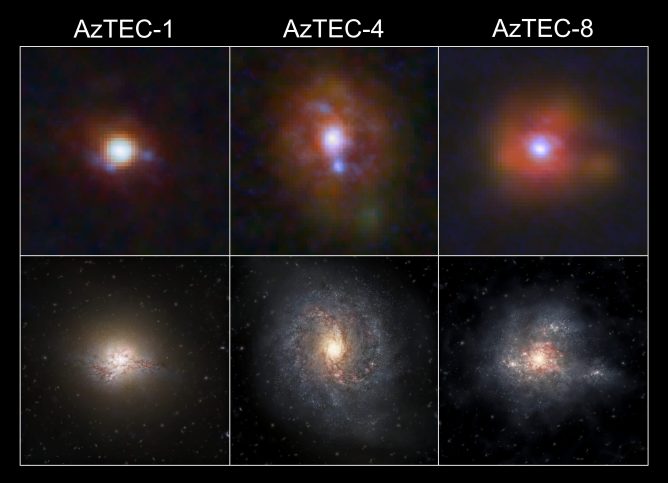2020.08.07
Stellar Egg Hunt with ALMA – Tracing Evolution from Embryo to Baby Star
Stars are formed by gravitational contraction of gaseous clouds. The densest parts of the clouds, called molecular cloud cores, are the very sites of star formation and mainly located along the Milky Way. The Taurus Molecular Cloud is one of the active star-forming regions and many telescopes have been pointed at the cloud. Previous observations show that some cores are actually stellar eggs before the birth of stars, but others already have infant stars inside.
A research team led by Kazuki Tokuda, an astronomer at Osaka Prefecture University and the National Astronomical Observatory of Japan (NAOJ), utilized the power of ALMA to investigate the inner structure of the stellar eggs. They observed 32 starless cores and nine cores with baby protostars. They detected radio waves from all of the nine cores with stars, but only 12 out of 32 starless cores showed a signal. The team concluded that these 12 eggs have developed internal structures, which shows they are more evolved than the 20 quite cores.

Wide-field far-infrared image of the Taurus Molecular Cloud obtained by the Herschel Space Observatory and stellar eggs observed with ALMA (insets).
Credit: ALMA (ESO/NAOJ/NRAO), Tokuda et al., ESA/Herschel
“Generally speaking, radio interferometers using many antennas, like ALMA, are not good at observing featureless objects like stellar eggs,” says Tokuda. “But in our observations, we purposely used only the 7-m antennas of ALMA. This compact array enables us to see objects with smooth structure, and we got information about the internal structure of the stellar eggs, just as we intended.”
Increasing the spacing between the antennas improves the resolution of a radio interferometer, but makes it difficult to detect extended objects. On the other hand, a compact array has lower resolution but allows us to see extended objects. This is why the team used ALMA’s compact array of 7-m antennas, as known as the Morita Array, not the extended array of 12-m antennas.
They found that there is a difference between the two groups in the gas density at the center of the dense cores. Once the density of the center of a dense core exceeds a certain threshold, about one million hydrogen molecules per cubic centimeter, self-gravity leads the egg to transform into a star.
Computer simulation movie of the evolution of a dense core to a first hydrostatic core. The present ALMA observations detected the central dense part (shown in red). This simulation was made by the supercomputer ATERUI-II operated by NAOJ.
Credit: Tomoaki Matsumoto (Hosei University)
Zoom-in movie of the simulated evolution of a dense core.
Credit: Tomoaki Matsumoto (Hosei University)
A census is also useful for finding a rare object. The team noticed that there is a weak but clear bipolar gas stream in one stellar egg. The size of the stream is rather small, and no infrared source has been identified in the dense core. These characteristics match well with the theoretical predictions of a “first hydrostatic core,” a short-lived object formed just before the birth of a baby star. “Several candidates for the first hydrostatic cores have been identified in other regions,” explains Kakeru Fujishiro, a member of the research team. “This is the first identification in the Taurus region. It is a good target for future extensive observation.”
Kengo Tachihara, an associate professor at Nagoya University mentions the role of Japanese researchers in this study. “Japanese astronomers have studied the baby stars and stellar eggs in Taurus using the Nagoya 4-m radio telescope and Nobeyama 45-m radio telescope since the 1990s. And, ALMA’s 7-m array was also developed by Japan. The present result is part of the culmination of these efforts.”
“We have succeeded in illustrating the growth history of stellar eggs up to their birth, and now we have established the method for the research,” summarizes Tokuda. “This is an important step to obtain a comprehensive understanding of star formation.”
Paper and Research Team
These observation results were presented in the following two papers published on August 7, 2020.
– K. Tokuda et al. “FRagmentation and Evolution of Dense Cores Judged by ALMA (FREJA). I (Overview). Inner ~1,000 au Structures of Prestellar/Protostellar Cores in Taurus,” The Astrophysical Journal.
– K. Fujishiro et al. “A Low-velocity Bipolar Outflow from a Deeply Embedded Object in Taurus Revealed by the Atacama Compact Array,” The Astrophysical Journal Letters.
The research team members are:
Kazuki Tokuda (Osaka Prefecture University/National Astronomical Observatory of Japan), Kakeru Fujishiro (Nagoya University), Kengo Tachihara (Nagoya University), Tatsuyuki Takashima (Osaka Prefecture University), Yasuo Fukui (Nagoya University), Sarolta Zahorecz (Osaka Prefecture University/National Astronomical Observatory of Japan), Kazuya Saigo (National Astronomical Observatory of Japan), Tomoaki Matsumoto (Hosei University), Kengo Tomida (Tohoku University), Masahiro N. Machida (Kyushu University), Shu-ichiro Inutsuka (Nagoya University), Philippe André (CEA Saclay), Akiko Kawamura (National Astronomical Observatory of Japan), and Toshikazu Onishi (Osaka Prefecture University)
This research was supported by JSPS KAKENHI (No. 18K13582, and 18H05440), and NAOJ ALMA Scientific Research Grant (2016-03B).
The Atacama Large Millimeter/submillimeter Array (ALMA), an international astronomy facility, is a partnership of the European Southern Observatory (ESO), the U.S. National Science Foundation (NSF) and the National Institutes of Natural Sciences (NINS) of Japan in cooperation with the Republic of Chile. ALMA is funded by ESO on behalf of its Member States, by NSF in cooperation with the National Research Council of Canada (NRC) and the Ministry of Science and Technology (MOST) in Taiwan and by NINS in cooperation with the Academia Sinica (AS) in Taiwan and the Korea Astronomy and Space Science Institute (KASI).
ALMA construction and operations are led by ESO on behalf of its Member States; by the National Radio Astronomy Observatory (NRAO), managed by Associated Universities, Inc. (AUI), on behalf of North America; and by the National Astronomical Observatory of Japan (NAOJ) on behalf of East Asia. The Joint ALMA Observatory (JAO) provides the unified leadership and management of the construction, commissioning and operation of ALMA.









